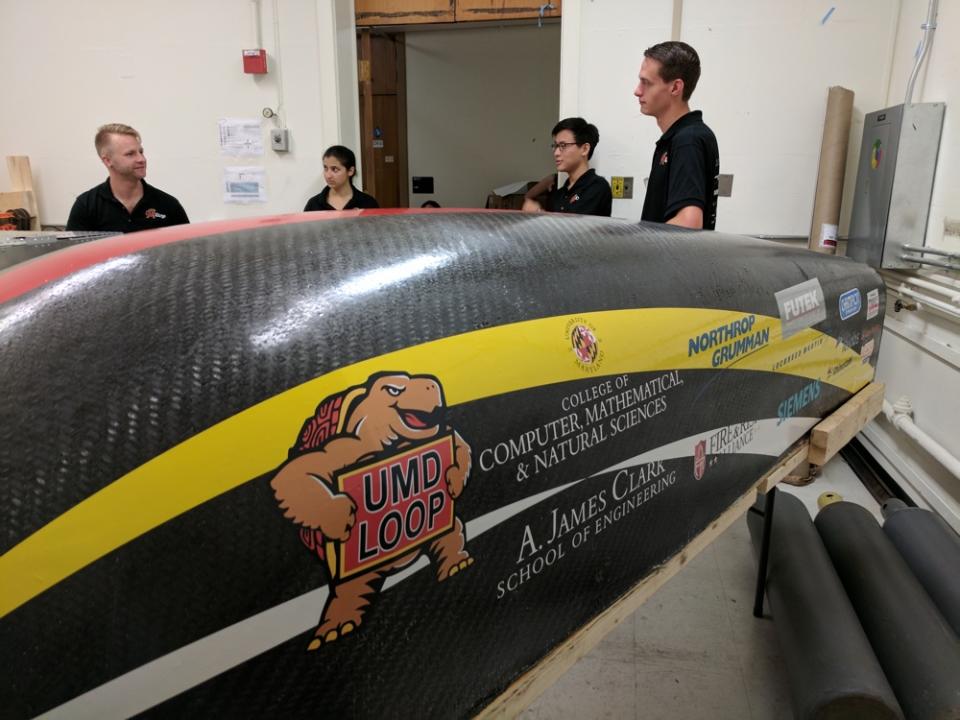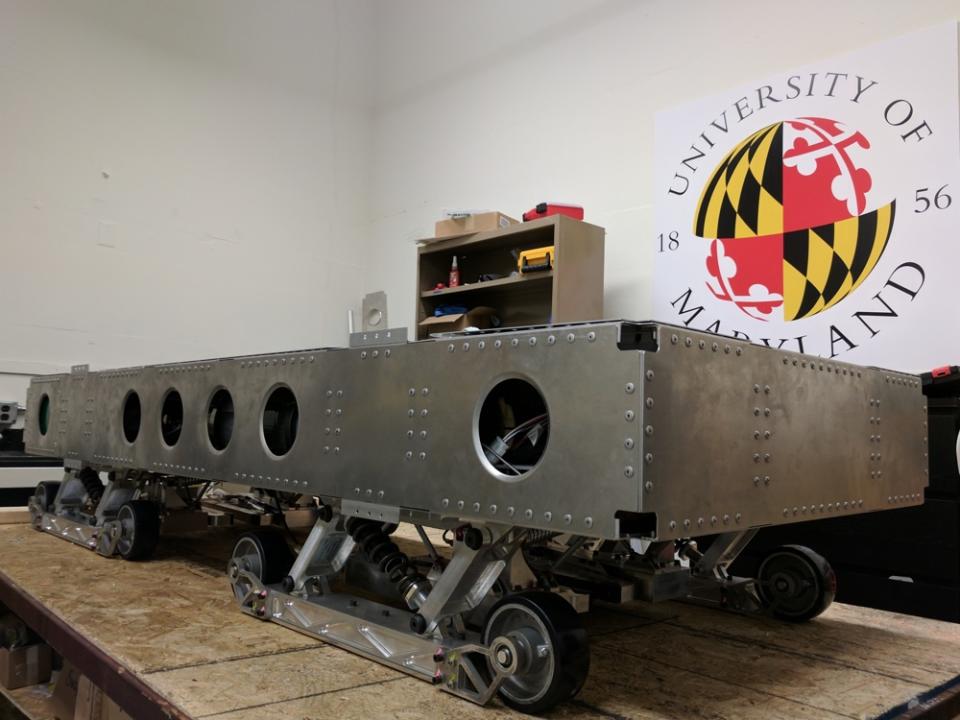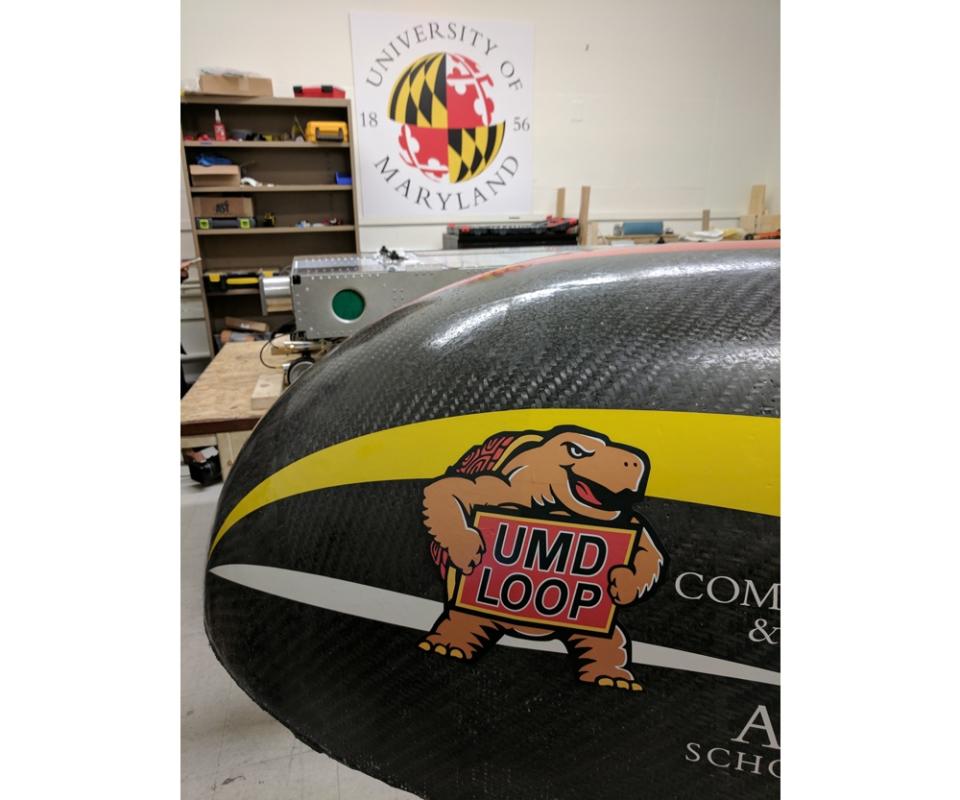These college students are vying to build Elon Musk's hyperloop

It may take years to see if Elon Musk’s dream of a hyperloop will lead to humans zipping between cities at hundreds of miles an hour aboard pods packed inside low-pressure tubes, but one team of college students is sure they can help lead the way there.
And starting later this month, they and 23 other teams will have a chance to prove it by competing in SpaceX’s Hyperloop Pod Competition, where they’ll send their own pod flying down a mile-long test track at the company’s headquarters in Hawthorne, California.
Meet Nemesis
The University of Maryland’s UMD Loop team showed off their entry at the school’s College Park, Md., campus Tuesday morning. Their entry, named Nemesis, consists of two parts: an aluminum frame containing all the electronic and mechanical systems, and a streamlined carbon-fiber shell atop that.
“We are at about three months building it,” explained systems lead Mike Rennie, 29, in a room at UMD’s Institute for Physical Science and Technology. He put the cost of this prototype at about $90,000 after some machining mistakes and do-overs of components like the circuit board holding the pod’s computer.
The roughly 450-pound assembly starts its journey on four sets of polyurethane wheels as it gets pushed down the hyperloop tube by the functional equivalent of the spring launcher in a pinball machine. The pod should begin levitating magnetically at about 11 mph, said his colleague Shelly Szanto, 19, and continue picking up speed rapidly until its pusher plate is free of the launcher.

“Then it’s us from there,” she said. That is, while the hyperloop concept employs a series of magnets to sling each pod down the track, the test track doesn’t provide propulsion and instead lets each pod coast.
The design speed of Nemesis is about 180 mph, although team members said they weren’t sure what would happen if it went faster. At the end of the test track, Nemesis should brake to a halt using magnets on its underside.
If the undergrads need to do some last-minute tweaks when the competition kicks off, they’ll plenty of help close by: Sponsors Northrop Grumman (NOC) and Lockheed Martin (LMT) have facilities near SpaceX’s headquarters.
Engineering challenges
The team of engineering students has been through this once before. At a hyperloop competition hosted by SpaceX in January, an earlier prototype called Prometheus placed fifth overall and finished first in the “operations” and performance category.
This time around, the contest rules specify only one goal: “maximum speed with successful deceleration (i.e. without crashing).”
Nemesis will come with an array of accelerometers and other sensors to track its position inside the test track, plus a GoPro (GPRO) camera to record the view.

“SpaceX requires us to have a feedback of everything that’s going on inside the pod,” said team member Jeffrey Zhu, 19.
Prometheus carried a plush squirrel named Faraday, while Nemesis will also transport a stuffed version of UMD’s mascot, Testudo.
For the actual contest, the pod will need to carry an additional payload: a life-sized dummy. It will have to be stretched out under the windowless shroud, making the entire conveyance something like a coffin on a luge track.
The pod won’t be pressurized, although Rennie, an Army veteran, said the team could add a pressure vessel under the pod in “no more than a month.”
What about hyerlooping people?
The original idea behind the hyperloop, as SpaceX and Tesla (TSLA) founder Elon Musk laid out in a 2013 posting, imagined something more comfortable: capsules carrying 28 seated people that would rival planes and high-speed rail for trips of a few hundred miles between cities.
The UMD team professed faith in the basic idea — “this is 100% feasible,” Rennie said — but also admitted to some obstacles.

One is making a hyperloop trip not resemble an amusement park ride. Nemesis will accelerate down the tube fast enough to inflict 2.4 times the force of gravity on Faraday, Testudo and the dummy passenger—close to twice the g-force of a Tesla Model S rocketing from 0-60 mph at its “Ludicrous” setting.
Team member Chris Moseman, 21, called that “one of the biggest limiting factors.”
Companies working to turn Musk’s concept into operating infrastructure say they will accelerate their pods more slowly and keep curves gentle enough to avoid inflicting punishing levels of sideways g-forces. Hyperloop One co-founder Josh Giegel promised a “grandma-friendly, kid-friendly and vomit-free” ride at last year’s Web Summit conference.

But the hardest obstacle may be building hyperloop tubes in the crowded spaces between cities. Hyperloop One’s first route will span the mostly-open expanse from Dubai to Abu Dhabi.
But Musk’s recent, cryptic tweet about receiving “verbal govt. approval” for a 29-minute tunneled route from Washington to New York suggests somewhat less civil-engineering realism. He says yet another one of his ventures, the Boring Company, will make that possible by digging tunnels much faster and cheaper than today’s technology allows.
But before any of those things can happen, Nemesis and its 23 rivals have to prove they can make it a mile down a straight-line track.
And for the UMD team’s entry, that journey starts with an older form of transportation: the truck hauling the pod from College Park to L.A.
More from Rob:
A massive EU privacy rule could bring an unexpected benefit for US consumers
Apple’s decision to drop privacy apps in China might not be the last of its kind
Email Rob at [email protected]; follow him on Twitter at @robpegoraro.
